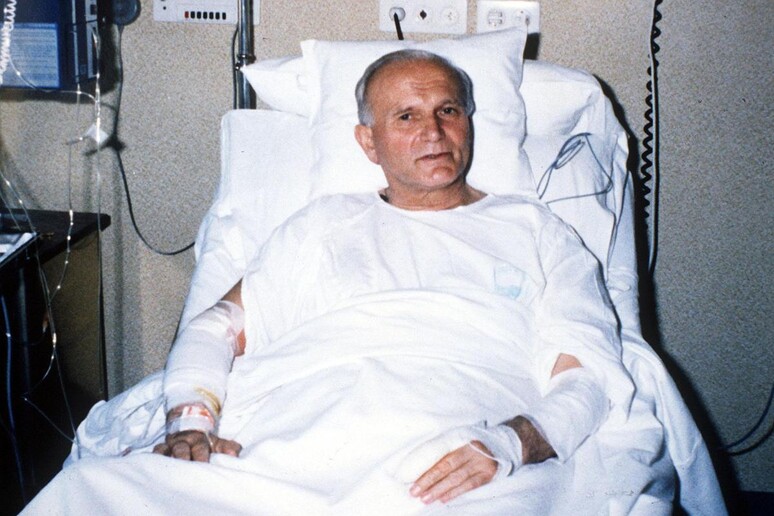(By Elisa Cecchi).
Cardinal Agostino Vallini, the vicar general of the pontiff for the diocese of Rome, on 1 May 2011 read a biography of Pope John Paul II during the official request for beatification in St. Peter's Square.
"Karol Josef Wojtyla, elected pope on 16 October 1978, was born in Wadowice (Poland) on 18 May 1920", the biography stated.
"He was the second of two children of Karol Wojtyla and Emilia Kaczorowska, who died in 1929. His older brother Edmund, a doctor, died in 1932, his father, a non-commissioned officer, in 1941. He received first Communion at 9 and was confirmed at 18. After graduating high school in Wadowice, in 1938 he enrolled in Jegellnica University in Krakow. When occupying Nazi forces closed the university in 1938, Karol worked (1940-1944) in a mine and then at a chemical Solvay plant to make a living and avoid deportation to Germany. In 1942 he felt the call to the priesthood, attending Krakow's seminary directed by Cardinal Adam Stefan Sapieha. Meanwhile he a promoter of the secret 'Rapsodico' Theatre.
After the war, he continued to study at the main seminary of Krakow and the Theology department of Jegellnica University until he was ordained a priest on 1 November 1946.
He was subsequently sent by Cardinal Sapieha to Rome where he obtained a PhD in theology (1948) with a thesis on faith in the works of St. John of the Cross.
During that period, he worked as a priest among Polish immigrants in France, Belgium and the Netherlands.
In 1948 he returned to Poland and was first appointed a coadjutor at the parish church of Niegowi, near Krakow, and then in Saint Florian within the city. He was a university chaplain until 1951, when he resumed his studies in philosophy and theology.
In 1953 he completed a thesis on the possibility of founding a Christian ethic based on Max Scheler's ethical system at the Catholic University of Lublin. Later, he became a professor of moral theology and ethics at the major seminary in Krakow and at the theology faculty in Lublin.
On 4 July 1958, Pius XII appointed him as auxiliary bishop of Krakow and titular bishop of Ombi.He was ordained on 28 September 1958 in Wawel cathedral, Krakow, by Archbishop Eugeniusz Baziak.On 13 January 1964 he was appointed archbishop of Krakow by Paul VI who named him cardinal on 26 June 1967.
He took part in the Second Vatican Council (1962-1965), playing a significant role in drafting the pastoral constitution Gaudium et Spes.
Cardinal Wojtyla also took part in five assemblies of the Synod of Bishops before his pontificate.
He was elected pope on 16 October 1978 and his ministry as Universal Pastor of the Church began on 22 October.
John Paul II carried out 164 pastoral trips in Italy and, as bishop of Rome, he visited 317 of today's 332 Roman parishes.
His worldwide pastoral trips, expression of the pastoral solicitude of Peter's successor for all Churches, were 104.
Among his main documents are 14 Encyclicals, 15 Apostolic Exhortations, 11 Apostolic Constitutions and 45 Apostolic Letters He also wrote five books during his pontificate: "Crossing the threshold of hope" (October 1994); "Gift and mystery on the fiftieth anniversary of my priestly ordination" (November 1996); "The poetry of John Paul II, Roman Triptych, Meditations" (March 2003); "Rise, let us be on our way" (May 2004); and "Memory and identity" (February 2005).
He celebrated 147 rites of beatification at which he proclaimed 1,338 blessed, and 51 canonizations thereby arriving at a total of 482 saints.He held nine consistories during which he created 231 cardinals (plus one in pectore). He also chaired six plenary meetings of the College of Cardinals.
From the year 1978 he summoned 15 assemblies of the Synod of Bishops: six ordinary general assemblies of the Synod of Bishops (1980, 1983, 1987, 1990, 1994 and 2001), one extraordinary general assembly (1985) and eight special assemblies (1980, 1991, 1994, 1995, 1997, 1998 and 1999).
On 13 May 1981, he was seriously injured in an attack in Saint Peter's square. Saved by the Mother of God, after a long convalescence period, he forgave his attacker and intensified his pastoral engagements with heroic generosity.
His solicitude as a pastor was expressed through the creation of several dioceses and ecclesiastical districts, the promulgation of the Codes of Canon Law and the Code of Canons of Eastern Churches, of Catechism of the Catholic Church.
He offered to the people of God moments of particular spiritual intensity, calling the Year of Redemption, the Marian Year, the Year of the Eucharist and the Great Jubilee of 2000.
He attracted youths with the institution of World Youth Day.
No pope met as many people as John Paul II.
Over 17.6 million pilgrims attended general audiences on Wednesdays (over 1,160), without counting special audiences and religious ceremonies (over eight million pilgrims during the 2000 Jubilee alone).He met millions of faithful during pastoral trips in Italy and abroad.He also received many government leaders during audiences: 38 official visits and 738 other audiences or meetings with heads of State, as well as 246 audiences and meetings with prime ministers.
He died in Rome, at the Vatican Apostolic Palace, on 2 April 2005, at 9.37 pm, on the eve of the Dominica in Albis, or Divine Mercy Sunday, he had created. The solemn funeral in St.
Peter's Square and burial in the grottos of the Vatican basilica were held on 8 April".
ALL RIGHTS RESERVED © Copyright ANSA











